5 Ways to Use Long-form Content in Digital Marketing

Long-form content has been a powerful tool to build trust, engage audiences, and get quality leads. It’s been a growing trend in recent times, with marketers using it to provide in-depth information about topics related to their products or services.
In 2024, making your long-form content stand out is crucial. This article will help you do just that.
But before that, let’s understand what long-form content is.
Typically, long-form content is over 700 words, though some say it should start at 1,200 or even 1,500 words to truly be long-form.
This type of content can take various shapes:
- Blogs
- Trend articles
- Email updates
- List articles
- How-to guides
- Interviews
- Case studies
- eBooks
- Whitepapers
When brands invest in long-form content, they nurture customer relationships and build active online communities, especially on social media platforms. For instance, longer blogs tend to get 24% more shares, according to Semrush.
Additionally, being at the top of search results is crucial. Backlinko found that the top-ranked result in a Google search is 10x more likely to get clicked than the tenth. And if you’re in the top three, you capture nearly 54.4% of all clicks.
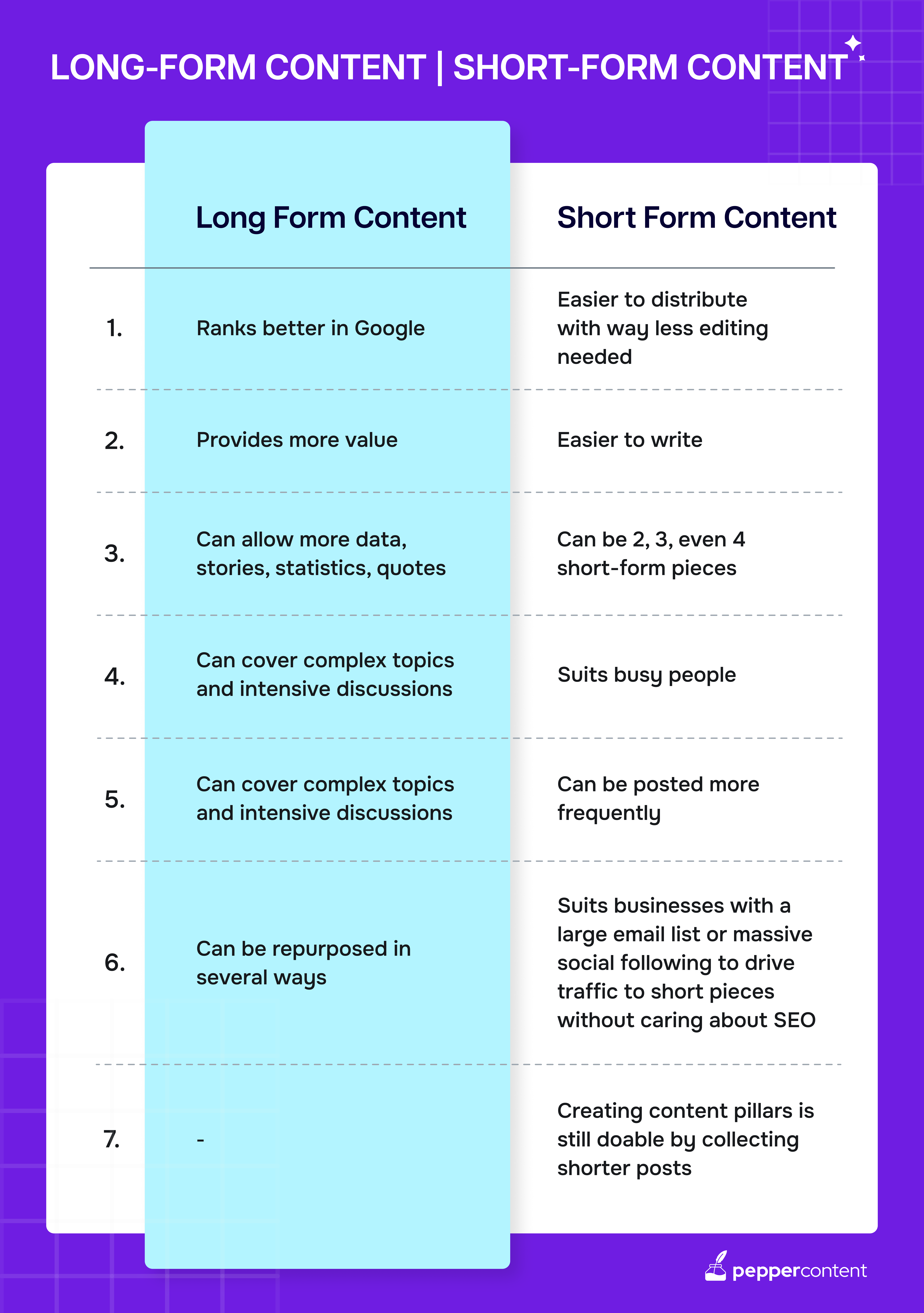
Furthermore, longer content can boost your site’s search ranking. Just a three-second increase in visitors’ time on your page can push you up one spot in search results, as per Backlinko’s research. Plus, longer pieces tend to get more backlinks, enhancing your SEO. Semrush discovered that content around 900-1,200 words gets 75% more backlinks than shorter content.
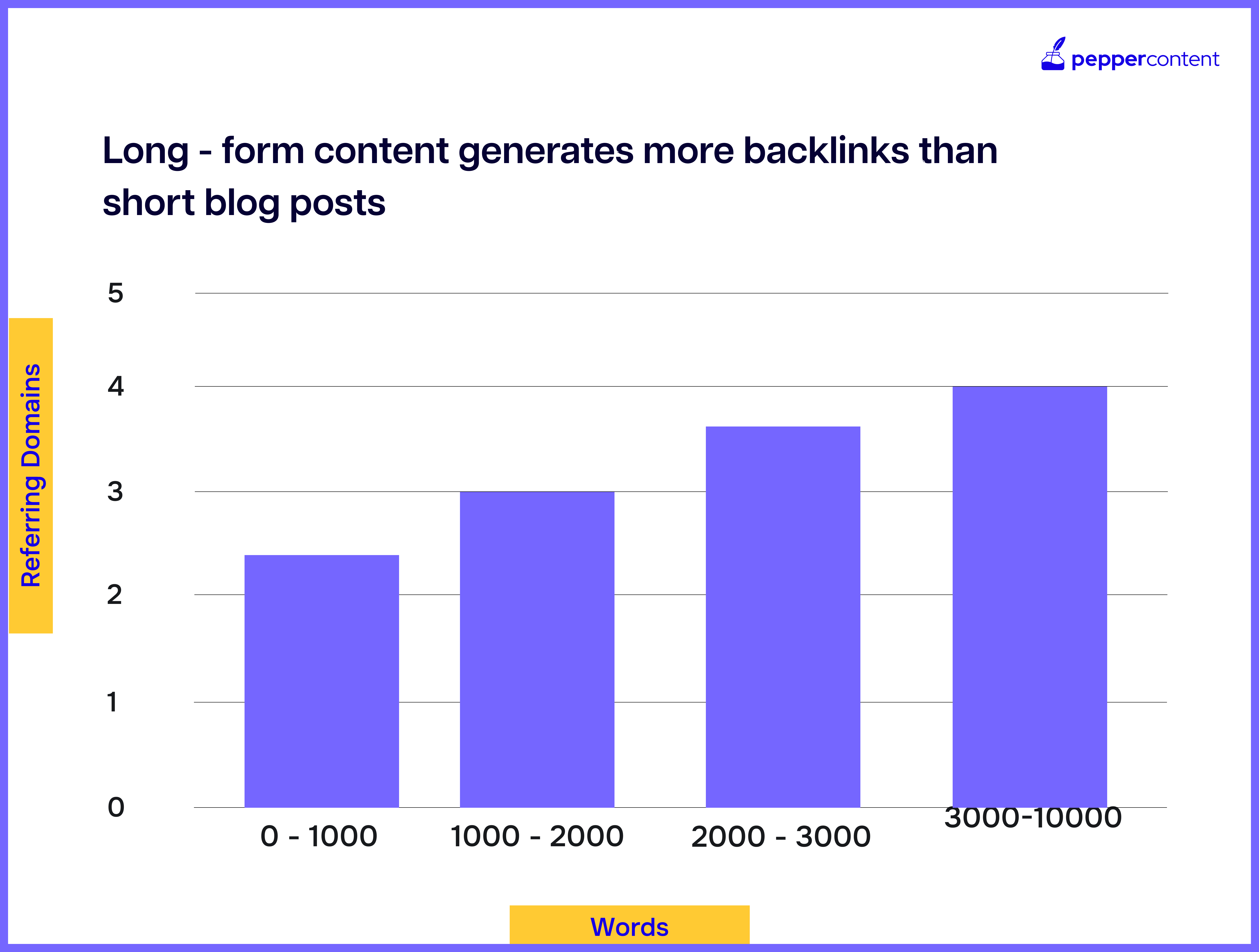
Having said that, let’s dive deeper into how businesses can use long-form content for digital marketing efforts.
Identifying and Targeting the Right Audience
Understanding your target audience is essential when brainstorming topics that truly resonate. Start by analyzing your existing blog or email newsletter: what content has gained traction? Which topics consistently attract your audience?
After that, dive into keyword research using tools like Google Keyword Planner or Semrush. These tools can tap into the specific words and phrases your target audience frequently searches for, offering valuable insights.
Additionally, tap into your audience’s challenges. Engage with your customer service and sales teams to identify recurring issues or questions from clients. This direct feedback can spark content ideas that address real needs.
Lastly, keep an eye on your competitors. While you shouldn’t replicate their content, understanding their topics can guide you. Focus on crafting content that highlights the unique aspects of your product or service, setting you apart in the market.
Take Drift, for example. As a revenue acceleration platform, Drift’s blog, Drift Insider, epitomizes the art of targeting and engaging the right audience.
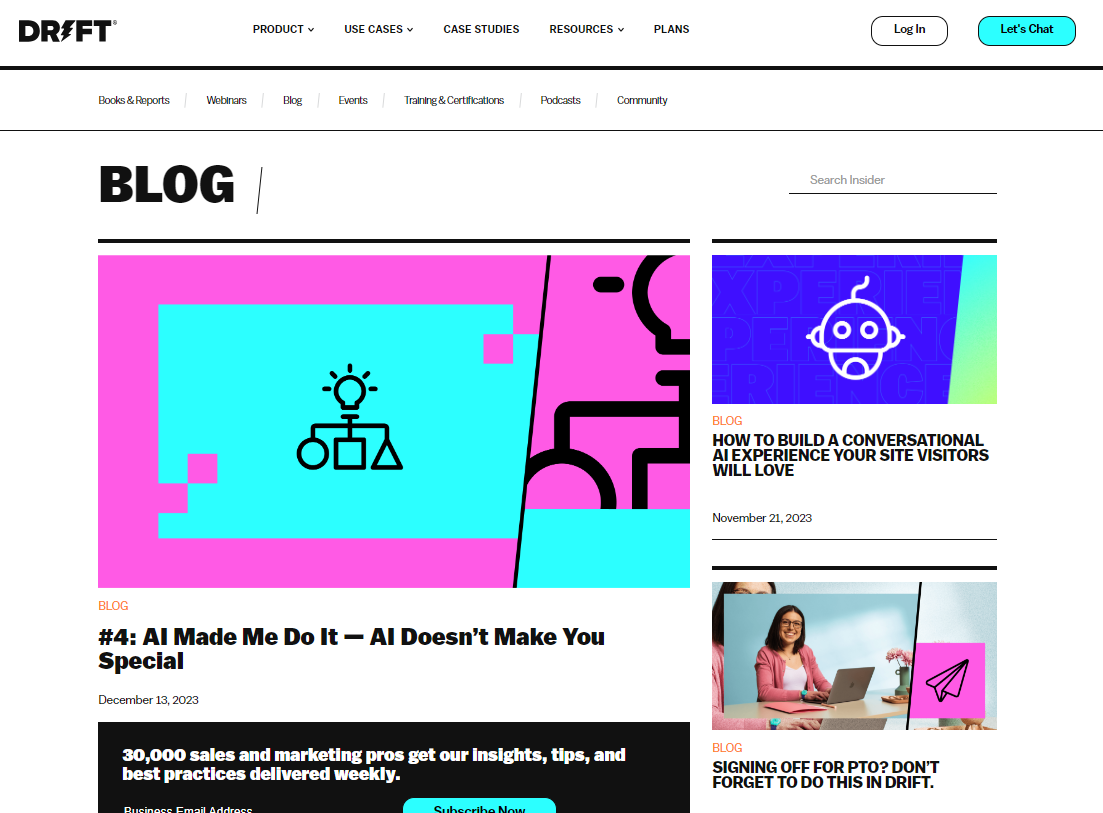
Drift Insider features a mix of data-driven stories, impactful campaign case studies, opinion pieces, and interviews with interview leaders. This content focuses on individuals invested in revenue growth, sales strategies, and customer engagement.
With a sharp focus on understanding its audience, integrating relevant keywords, and grasping search intent, Drift has successfully built a dedicated following, solidifying its position as a thought leader in revenue growth discussions.
Content Quality and Competitor Analysis
Typically, long-form content focuses on depth and quality over quantity.
While short-form content thrives on frequency due to its timely nature, creating long-form content requires meticulous planning, thorough research, and conscious formatting.
B2B content marketers crafting long-form content have to consider multiple ideas or concepts at once while also ensuring each piece is easy to navigate, engaging, and delivers valuable insights to their audience.
Here are some more advantages of creating high-quality, long-form content:
- Audience Trust and Engagement: A 2022 study by the Content Marketing Institute (CMI) indicated that the number one challenge for B2B organizations is difficulty creating content that appeals to the different stages of a buyer’s journey. And only a mere 2% of marketers say they do not face any challenges.
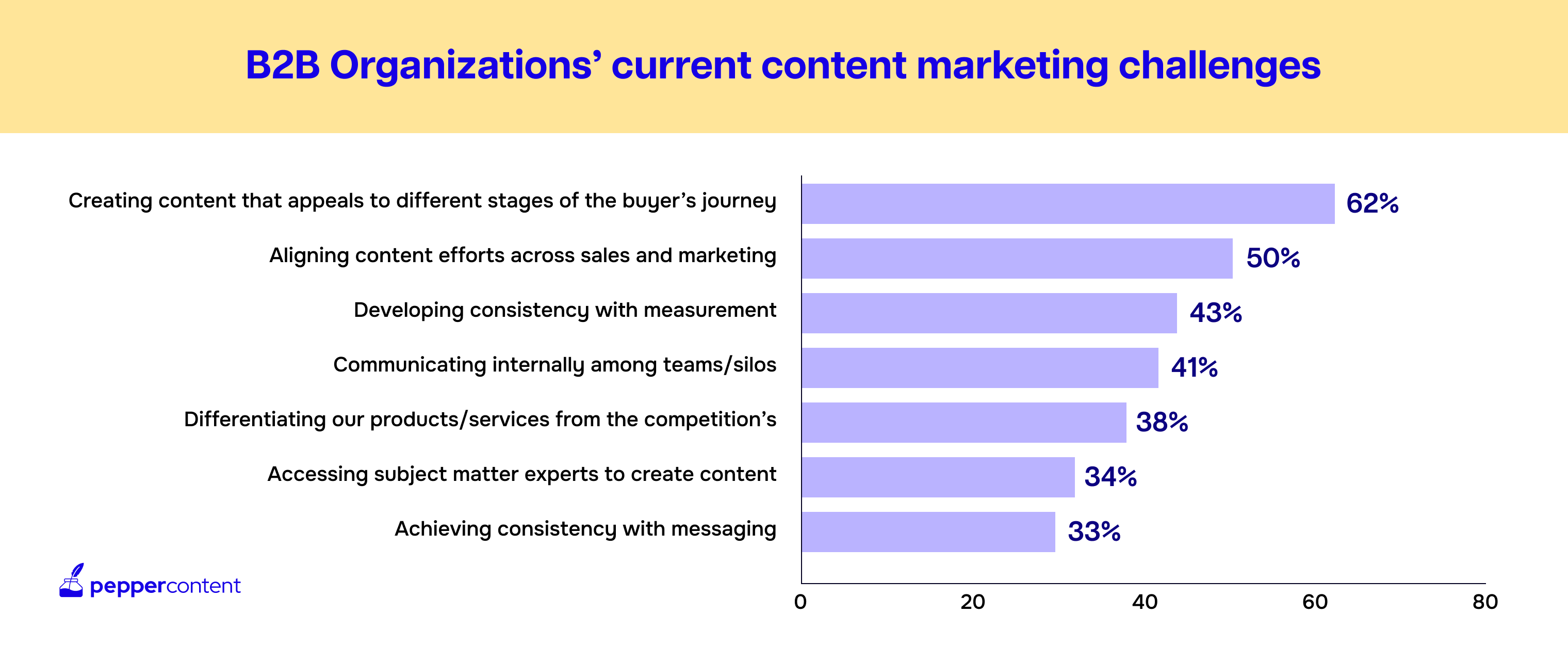
The thing is, if you lack engaging content, it sets off a chain reaction, pushing all your marketing efforts to failure. High-quality content establishes credibility, fostering trust among your target audience. When readers consistently find value in your content, they are more likely to engage, share, and convert.
- Search Engine Visibility: Search engines prioritize content that offers genuine value to users. By delivering superior content, you enhance your chances of ranking higher in search engine results, driving organic traffic and visibility.
- Competitive Advantage: With your competitors sharing content on similar topics, quality becomes your distinguishing factor. High-quality content not only elevates your brand but also positions you as an industry leader, drawing potential customers and partners.
MailChimp’s commitment to delivering quality content is evident through its in-depth articles, expert interviews, and comprehensive guides. For example, this is an in-depth guide on how to set up Google Remarketing Ads.
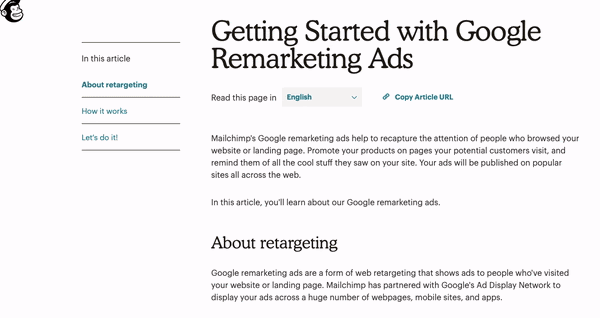
What sets this piece apart is its user-friendly features like a table of contents, multilingual options, and easy social sharing capabilities. A table of contents helps readers navigate lengthy content, allowing them to pinpoint specific sections of interest. Furthermore, with language options, international audiences can seamlessly translate and engage with the content in their preferred language.
By consistently producing long-form content that addresses current trends, challenges, and innovations in the digital landscape, SEJ has carved a niche for itself, overshadowing many competitors in email marketing, paid search, and digital marketing.
Structuring Long-Form Content for Maximum Engagement
Creating compelling long-form content goes beyond just presenting information; it involves structuring that information to engage and retain audience attention. Here’s how you can optimize your content structure:
- Clear Headings and Subheadings: Break down your content using descriptive headings and subheadings. This not only organizes your content but also allows readers to quickly identify sections of interest, facilitating easy navigation.
- Bullet Points and Lists: Incorporate bullet points, numbered lists, or checklists to highlight key points or steps. These elements create visual breaks, making it easier for readers to digest information and locate specific details.
- Short Paragraphs: Long paragraphs can make businesses lose readers. Opt for concise paragraphs that convey a single idea or point, maintaining a balance between detail and brevity.
Organizing your content logically is key to ensuring that readers remain engaged from beginning to end. Present ideas, arguments, or steps in a structured manner, ensuring a cohesive narrative that resonates with readers.
Additionally, the strategic use of visual elements can significantly enhance engagement and understanding. Incorporate relevant images, diagrams, or infographics to complement your text. Visual elements enhance engagement and aid understanding, especially for complex concepts or data-driven insights.
Highlighting key quotes, statistics, or insights using pull quotes or highlight boxes can further draw attention to critical information, encouraging readers to dive deeper into the content. For content that involves data/statistics, utilize charts, graphs, or tables to present information visually. These visual aids simplify complex data sets, making them more accessible and engaging for readers.
Leveraging Long-Form Content for SEO and Social Media Success
Longer content typically performs better in search engine rankings for several reasons, such as greater return traffic, increased social sharing, and significantly more backlinks (77%) — a critical factor considered by Google’s ranking algorithm, as highlighted by Backlinko.
Additionally, data from LocaliQ reveals that the typical word count for content featured in Google’s top 10 results averages around 2,450 words. Long-form content that resonates with audiences tends to generate higher engagement rates on social media platforms. By addressing audience pain points, providing actionable insights, or presenting unique perspectives, you encourage readers to share your content across their social networks, thereby amplifying its reach and visibility.
Therefore, investing in long-form content can strategically position your content for sustained visibility on search engine results pages, ultimately driving enhanced lead generation and sales opportunities.
Establishing Authority and Building Trust
Long-form content allows brands to explore topics in-depth, providing readers with comprehensive insights, analyses, and perspectives. By addressing complex subjects, sharing research findings, or offering detailed guides, brands can position themselves as knowledgeable authorities within their respective fields.
Moreover, it offers brands an opportunity to engage audiences authentically. By sharing detailed case studies, customer testimonials, or behind-the-scenes insights, brands can build transparency, fostering trust and credibility among their audience.
For example, Animalz leverages long-form content to share industry-specific insights, trends, and best practices. It specializes in crafting “bottom of the funnel thought leadership” articles strategically designed to generate leads and close deals. For example, take this detailed piece on Twitter’s thought leadership.
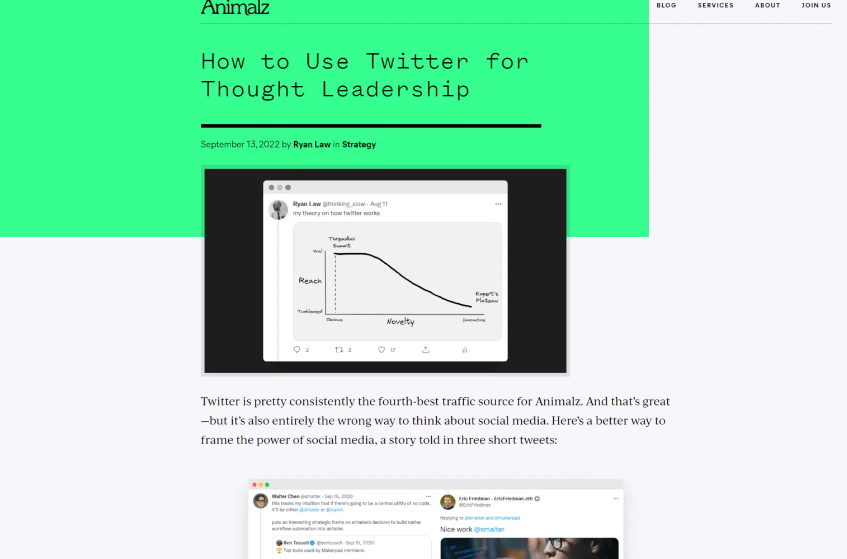
In this long-form content piece, Animalz stands out distinctively by introducing fresh and original tips, such as strategies for building equity in a personal brand, to foster the growth of your Twitter followers.
Sharing this kind of content helps build trust and shows that your brand knows its objectives. It also sets your brand apart by sharing its unique viewpoint, strengthening your position in the market.
Practical Steps and Strategies for Creating Effective Long-Form Content
Creating impactful long-form content requires a structured approach that includes setting goals, conducting in-depth research, thoughtful and quality writing, compelling design, and strategic calls-to-action (CTAs).
Here’s a comprehensive guide to crafting long-form content that resonates with your audience:
- Start by outlining clear objectives for your content. Whether it’s educating your audience, driving conversions, or establishing authority, defining goals provides direction and purpose to your content strategy.
- Identify topics that resonate with your target audience’s interests, challenges, and questions. Conduct audience research, analyze industry trends, and leverage keyword insights to highlight relevant and timely topics.
- Conduct thorough research to gather credible data, insights, and resources. Utilize reputable sources, expert opinions, case studies, and statistical data to enhance the credibility and depth of your content.
- To enhance readability, organize your content with a clear structure, incorporating headings, subheadings, and bullet points. Maintain a logical flow, transitioning smoothly between ideas, arguments, or sections.
- Craft compelling, engaging content that captivates your audience’s attention, evokes emotion, and encourages continuous reading. Incorporate storytelling elements, real-world examples, and relatable scenarios to resonate with readers.
- Include a CTA that aligns with your content goals and encourages desired reader behavior. Whether it’s subscribing to a newsletter, downloading a resource, or making a purchase, guide readers toward the next step in their journey.
- Optimize your long-form content with relevant keywords, meta descriptions, and headers to boost visibility on search engines.
- Expand its reach by utilizing multiple channels like social media, email marketing, and content platforms. Encourage sharing and engagement to foster a community around your content.
- Regularly analyze performance metrics, gather feedback, and stay updated with industry trends to refine and enhance your content strategy for continued relevance and impact.
By staying abreast of evolving industry trends, you can iteratively refine and optimize your long-form content strategy. This iterative approach ensures your content remains relevant, valuable, and impactful, continuously meeting your audience’s evolving needs and expectations while solidifying your brand’s position as a trusted, authoritative resource within your industry.
Examples of Long-Form Content That Actually Works
1. Grammarly
Grammarly is an AI-powered writing tool specializing in refining grammar and punctuation. Through its blog, Grammarly offers invaluable writing advice and grammar insights tailored for both students and professionals.
One standout article titled “A Guide to Writing a Job Description” provides a comprehensive breakdown of creating job descriptions to attract potential candidates.
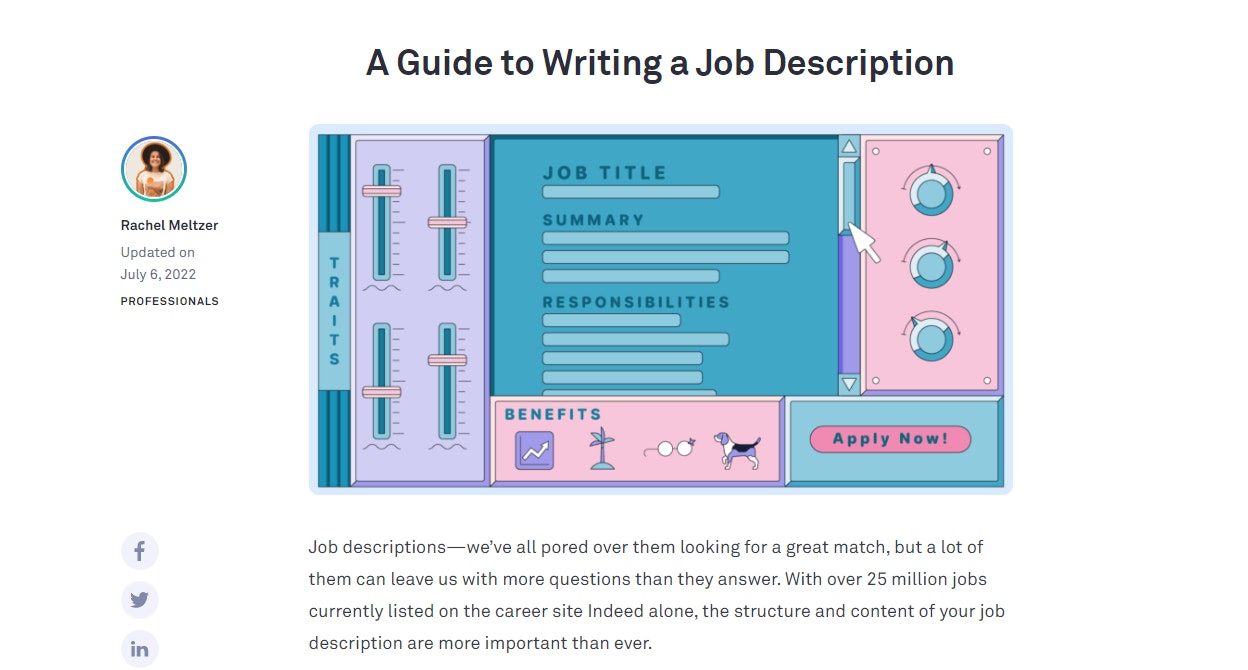
It works because the content resonates with Grammarly’s core audience. The article’s structured layout, with clear headings and subheadings, enhances readability. Moreover, it offers practical examples of compelling job descriptions and common pitfalls to sidestep.
2. Chevrolet
One of the most brilliant uses of long-form content is Chevrolet‘s captivating piece, “100 Years of Icons” — a journey through time with one of America’s most iconic automotive brands is a testament to the power of storytelling.
Starting its narrative in 1914 with the Royal Mail Roadster, the article not only highlights the evolution of automotive technology over the past century but also Chevrolet’s distinctive place in American culture. The piece sports striking visuals showcasing Chevy’s most legendary vehicles, Including photos of classic models like the El Camino, Camaro, and Corvette, capturing the essence of Chevrolet’s enduring legacy.
Chevrolet’s “100 Years of Icons” works because it offers gearheads’ in-depth vehicle specifications and reinforces the concept of longevity in both the brand’s and the manufacturer’s individual models. By immersing the reader in the brand’s history, Chevrolet taps into consumers’ desire for reliable and stylish cars in an entertaining and informative manner.
Wrapping Up
Crafting long-form content might seem challenging, but with the proper guidance, it becomes more manageable. By implementing the strategies mentioned earlier, you can be well on your way to achieving the content marketing objectives for your brand.
Looking for high-quality and well-optimized content? Don’t forget to check out Pepper Content’s expert-led writing services.
Latest Blogs
Explore how Google’s 2025 AI search updates triggered ranking chaos. Learn actionable strategies to adapt your SEO for AI Overviews, zero-click searches, and SERP volatility. Stay ahead now.
Learn how to rank on AI search engines like ChatGPT, Perplexity, and Gemini by optimizing your content for authority, structure, and relevance. Stay ahead in AI-driven search with this strategic guide.
Explore the best healthcare SEO services for your medical practice. Improve online visibility and effectively reach more patients in need of your services.
Get your hands on the latest news!
Similar Posts

Content Strategy
5 mins read
Choosing The Best Healthcare Marketing Agency For Effective Content Solutions

Content Marketing
4 mins read
Top 10 Agencies B2B SaaS Content Marketing for B2B Success

B2C Marketing
5 mins read